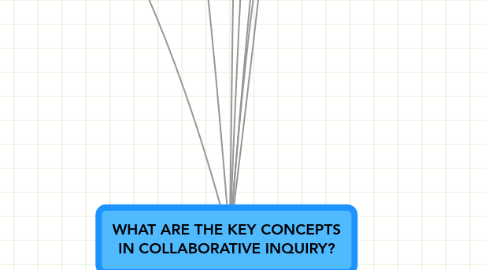WHAT ARE THE KEY CONCEPTS IN COLLABORATIVE INQUIRY?
por Mo Kap


1. Problem Solving
1.1. Data Collection
1.1.1. Methods & Sources
1.2. Evidence Anaysis
1.2.1. Valicdity & Accuray of Results
1.3. Consider demographics
1.4. Reflection Process
1.5. Cognitive Activity
1.5.1. How well does it represent what you are trying to measure
1.6. Each problem is unique and requires skills
1.7. Goal-oriented sequence of cognitive operations
1.7.1. mental representation of world
1.7.2. activity-based manipulation of problemspace
1.8. Problem Types
1.8.1. Logical
1.8.2. Algorithmic
1.8.3. Story
1.8.4. Rule-Uding
1.8.5. Disicion Making
1.8.6. Troubleshooting
1.8.7. Diagnosis-solution
1.8.8. Strategic Performance
1.8.9. Situated Case-Policy
1.8.10. Design
1.8.11. Dilemmas
1.9. multidimensional
1.9.1. problem type
1.9.2. individual differnces
1.10. problem representation
1.11. Complexity , Contest & Domain Knowledge
1.12. Experimentation with different methods
1.13. Independant Research
1.14. Action Research in the Classroom
2. Definition
3. BURNING QUESTON: What skills and technologies are essential for International Collaboration where F2F is not possible. I am particularly interested in collaboration between educators and researchers in the field of Indigenous education on an international, so that we may develop a greater understanding and appreciation for Indigenous learning systems.
4. REFERENCES: * Jonassen, D. H. (2000). Toward a Design Theory of Problem Solving. Educational Technology Research and Development, 48(4), 63-85. * Spiro, R. J., & DeSchryver, M. (2009). Constructivism: When It’s the Wrong Idea and When It’s the Only Idea. (Eds.) Signmund Tobias & Thomas M. Duffy Constructivist Instruction: Success or Failure. New York: Routledge. (Chapter p. 106-123) * http://www.edu.gov.on.ca/eng/literacynumeracy/inspire/research/CBS_CollaborativeInquiry.pdf
5. Inquiry
5.1. Developing a question
5.2. Formulating a Theory of Action
5.3. Proiritize Issues
5.4. Strong vs. Weak Questions
5.5. Discovery
5.6. Focus on cultural,social or intellectual value
5.7. Goal Setting
5.8. Common understanding of Essential information
5.9. Relevance to Context
5.10. Professional Discourse: Reflective, Adaptive, Iterative, Collaboartive
5.11. Selection of meaningful goal
6. Design
6.1. Recommendations
6.2. What are the implications of the Results ?
6.3. Adaptations
6.4. Consider culturally and emotional appropriate classroom design
6.5. Reflecting on Changes
7. Collaboration
7.1. Shared Vision
7.2. Meaningful Focus
7.3. Need for a Leader
7.3.1. Guidance
7.3.2. Refocussing
7.3.3. Direction
7.4. Conflict Resolution
7.5. Ensure everyone has a role
7.6. Sharing Ideas & Co-construction
7.7. Scaffolding
7.8. Modelling & Coaching
7.9. Engagement
7.10. Compromise
7.11. Domain structure
7.11.1. IIll-strucctured
7.11.2. Well Structured
7.12. Expanded perspectives
7.13. Volitional
8. Necessary Skills
8.1. Leadership Skills
8.1.1. BURNING QUESTION: How can a collaborative group establish a balance between the need for a leader, and the need for shared input?

